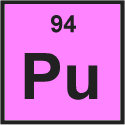|
|
- Symbol: Pu
- Atomic Number: 94
- Atomic Weight: 244
- Classification: Actinide
- Phase at Room Temperature: Solid
- Density: 19.816 grams per cm cubed
- Melting Point: 640°C, 1183°F
- Boiling Point: 3228°C, 5842°F
- Discovered by: Glenn Seaborg, Arthur Wahl, Edwin McMillan, and Joseph Kennedy in 1940
|
